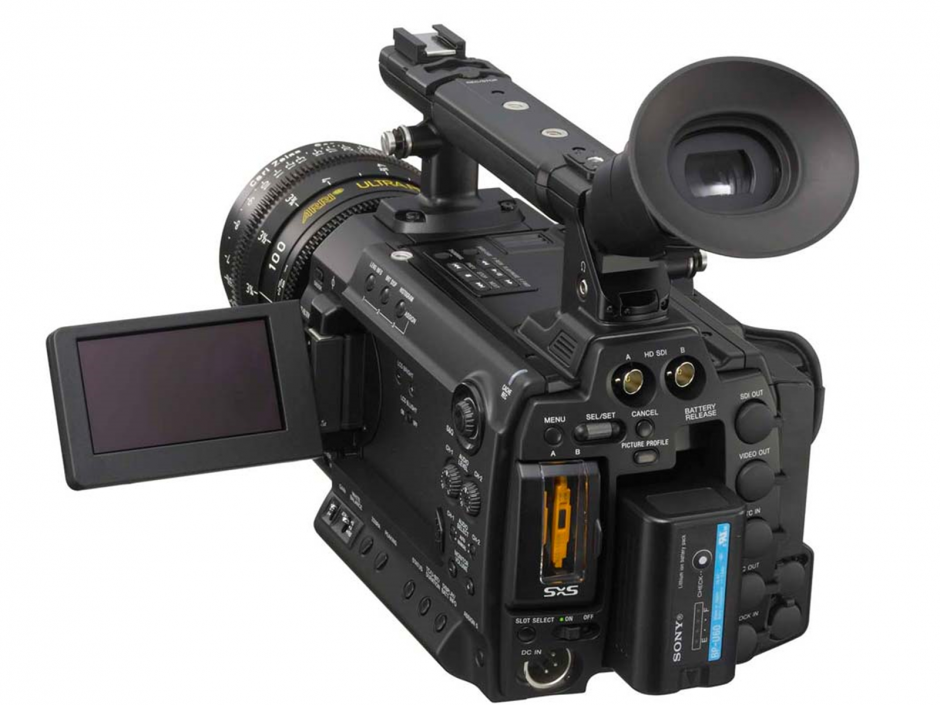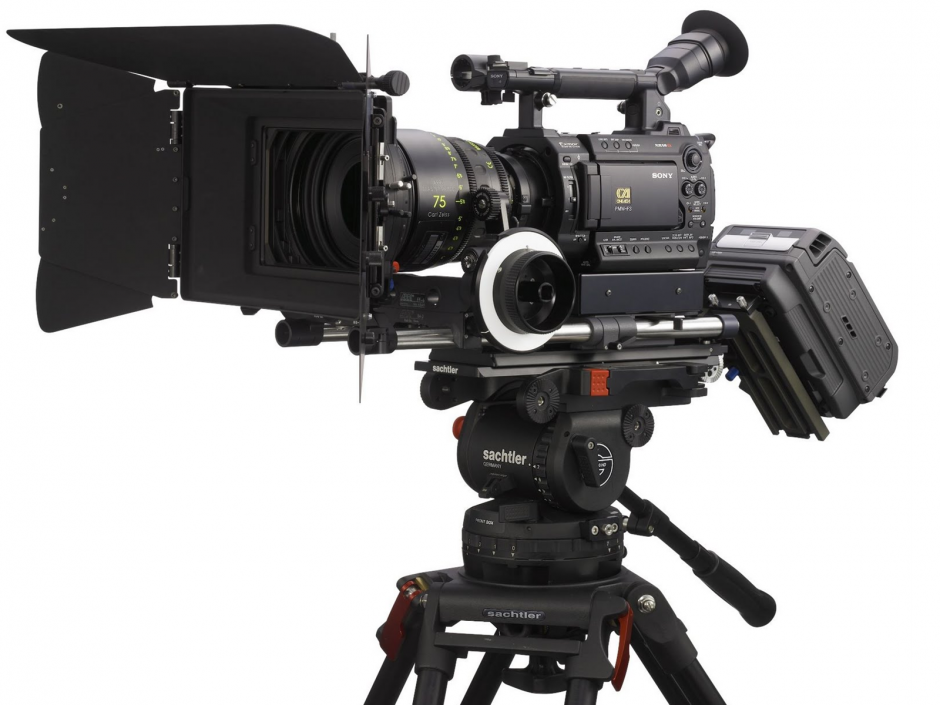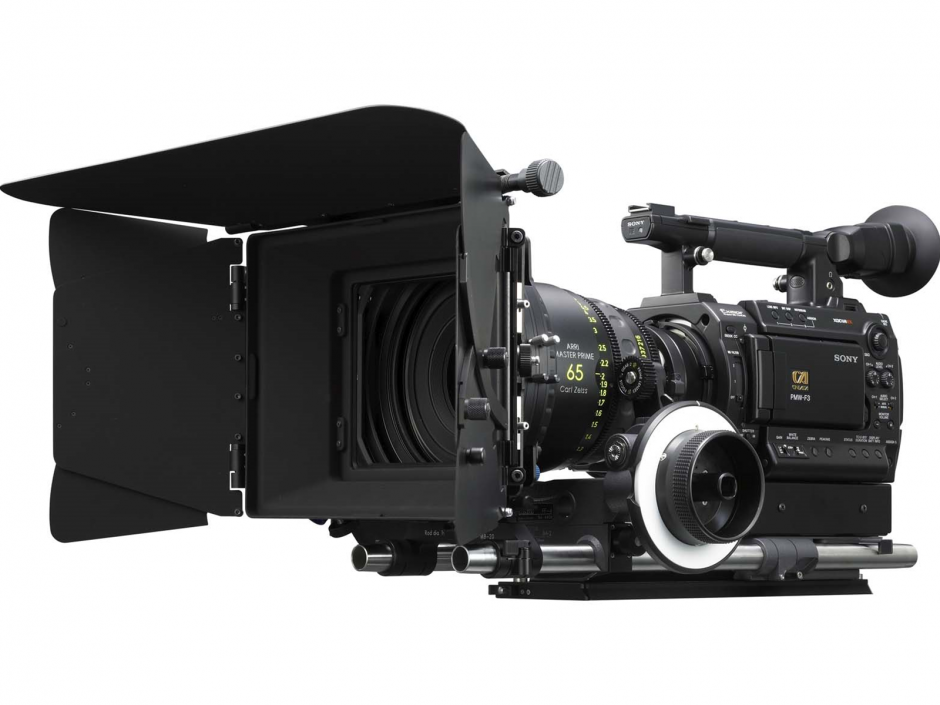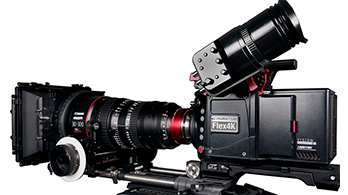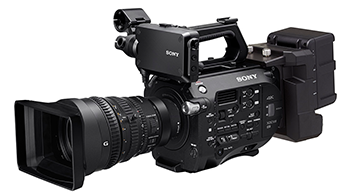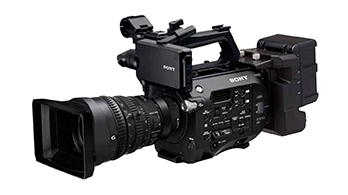Super 35mm image sensor
Amazing low-light sensitivity. Gorgeous highlight handling. Able to see into dark areas without undue noise. The PMW-F3 responds to light and color beautifully, as directors of photography can attest. It’s all made possible by an original Sony ExmorTM CMOS image sensor purpose-built for the PMW-F3. This is not some DSLR image sensor retrofitted for video. In fact, the F3 image sensor pixels are four times the size of typical DSLR pixels, equal to a two-stop advantage. It all adds up to one of the most eagerly anticipated cameras in Sony’s history.
Full Super 35mm image size
When it comes to image sensors, size definitely matters. Other things being equal, a bigger sensor equates to better low-light sensitivity and lower image noise. Even more important to some photographers is the pursuit of “bokeh,” the defocused backgrounds made possible by shallow depth of field. A common technique for directing audience attention within the frame, shallow depth of field is far easier to achieve with a large sensor. And that’s exactly what the PMW-F3 delivers, with a single sensor that closely approximates a Super 35mm film frame. Bigger sensors also make it easier to capture wide-angle shots; the field of view is wider for any given focal length lens.
 The Micro Four ThirdsTM sensor (left) imposes a significant crop factor versus 35mm. The PMW-F3 sensor has nearly twice the surface area of the Micro Four Thirds sensor in 16:9 operation, making the F3 a significantly better match to the Super 35mm film frame.
The Micro Four ThirdsTM sensor (left) imposes a significant crop factor versus 35mm. The PMW-F3 sensor has nearly twice the surface area of the Micro Four Thirds sensor in 16:9 operation, making the F3 a significantly better match to the Super 35mm film frame.
 Hold the three-CCD prism. The PMW-F3 features a single Super 35mm image sensor.
Hold the three-CCD prism. The PMW-F3 features a single Super 35mm image sensor.
Not just a bigger sensor, bigger pixels
Low-light sensitivity and powerful highlight handling depend in part on the imager size and also on the size of the pixels on that imager. That’s why Sony developed a new image sensor for the PMW-F3 with pixels that are four times the size of typical DSLR sensor pixels. Thanks to this two-stop advantage, the F3 achieves a sensitivity of F11 at a signal-to-noise ratio of 63 dB and an exposure index of ISO 800. Dynamic range extends to 460% of nominal peak white. All told, you’ll capture images of incredible exposure latitude, whether you’re seeing deep into the shadows at night or capturing the highlights in daytime exteriors.
RGB output
From color grading to compositing and chroma key the most demanding Hollywood postproduction processes benefit from RGB recording. Once an option, the CBK-RGB01 RGB and S-LOG Gamma output module is now standard equipment. This enables the camcorder to output an image with spectacular resolution, color quality and bit depth: uncompressed 10-bit RGB 4:4:4 1080p, over industry-standard Dual-link HD-SDI. You’ll be able to record this signal on the likes of Sony’s SRW-1 HDCAM SRTM recorder and the SR-R1 SRMasterTM recorder, either of which is capable of visually lossless 880 Megabits per second image capture. Simultaneous recording means you can capture to the XDCAM EXTM and HDCAM SR recordings in perfect sync, for simultaneous online and offline versions of your production.

Pure file-based 4:4:4 workflow with the SRW-1 HDCAM SR recorder and the CBK-RGB01 RGB and S-LOG Gamma upgrade.
Direct to edit
Right out of the box, the XDCAM EXTM system offers a mature workflow. In the edit bay, the XDCAM EX codec enables direct-to-edit operation with leading NLEs from Sony, Avid, Apple, Adobe and Edius. Final Cut Pro® users can take advantage of Sony’s affordable cinémon® plug-in for native, direct-to-edit operation—no need to rewrap files. The modest bitrate of XDCAM EX recording also enables fast, easy file transfers over data networks and affordable storage on hard disk arrays. And instead of burdening your production with data wrangling and backup headaches, Sony provides robust, reliable solutions.

It’s never been easier to go from shoot to edit.
S-LOG Gamma
For even greater recording capability, Sony includes the RGB and S-LOG Gamma output module, called the CBK-RGB01.
S-LOG Gamma represents unique encoding, carefully tailored to the capabilities of the PDW-F3 image sensor. S-LOG Gamma mimics the tonal response of a film negative, so you retain full flexibility in color correction and a seamless workflow with postproduction facilities geared toward Cineon® files, DPX files and other LOG encoded material.
With S-LOG Gamma encoding engaged, performance of the camera shifts to 800% dynamic range, at F16 sensitivity, 57 dB signal-to-noise ratio, exposure index 1600.
 Be the master of incredible dynamic range. Capture up to 800% of nominal peak white using Sony’s S-LOG Gamma upgrade.
Be the master of incredible dynamic range. Capture up to 800% of nominal peak white using Sony’s S-LOG Gamma upgrade. S-Log original picture, highlight and shadow detail is perfectly preserved but the picture looks flat, de-saturated. Notice the highlight detail in the tree.
S-Log original picture, highlight and shadow detail is perfectly preserved but the picture looks flat, de-saturated. Notice the highlight detail in the tree. S-Log picture color corrected for REC-709 video monitor, example. With S-Log + Color Correction + Video LUT, highlight detail is saved and shadows, mid-tones also look good without additional work. Notice the highlight detail in the tree is preserved. By using a Cineon LUT even more detail can be preserved in the final grade.
S-Log picture color corrected for REC-709 video monitor, example. With S-Log + Color Correction + Video LUT, highlight detail is saved and shadows, mid-tones also look good without additional work. Notice the highlight detail in the tree is preserved. By using a Cineon LUT even more detail can be preserved in the final grade.To integrate S-LOG Gamma into highly efficient color correction and editing workflows, FilmLight™ offers the Truelight™ plug-in for Adobe® After Effects®, Adobe Photoshop®, The Foundry™ Nuke™, Apple® Shake® and Eyeon™ Digital Fusion™ systems. The plug-in converts the S-LOG color space on the fly into conventional Rec.709 video, color corrected Rec.709, film print emulation and more.
For technical information on how to optimize images in the
S-LOG Gamma workflow and how to interface with Cineon files, DPX files and the ASC Color Decision List (CDL), we invite you to consult our S-LOG Gamma White Paper.
 The Truelight plug-in from FilmLight™ converts S-LOG gamma footage on the fly.
The Truelight plug-in from FilmLight™ converts S-LOG gamma footage on the fly.
 S-LOG Gamma enables you to capture images that go way over 100% of the image sensor’s nominal peak white and still protect against harsh highlight clipping.
S-LOG Gamma enables you to capture images that go way over 100% of the image sensor’s nominal peak white and still protect against harsh highlight clipping.
LUT Support
Without the correct processing, Sony’s S-LOG Gamma appears “flat,” missing deep blacks or piercing highlights. While many DPs are accustomed to looking at such LOG encoded images, many producers and clients are not. For this reason, Sony Look-up-Tables (LUTs) convert S-LOG Gamma to conventional Rec. 709 video for real-time monitoring on the set and for offline recording onto SxS memory cards. With the included CBK-RGB01 RGB and S-LOG output option, you get four viewing LUTs.
 LUT support enables you to have it both ways: S-LOG Gamma output for super-quality outboard recording, plus Rec.709 outputfor on-set monitoring and on-board recording.
LUT support enables you to have it both ways: S-LOG Gamma output for super-quality outboard recording, plus Rec.709 outputfor on-set monitoring and on-board recording.For example, the S-LOG to R709 conversion LUT delivers converted images to the HD-SDI output, for monitoring in the field. You can also “bake in” the LUT to images recorded on SxS cards, suitable for making EDL/ALE off-line files. At the same time, you can record S-LOG encoded RGB output onto HDCAM SRTM tapes and use these as on-line material. By using both HDCAM SR tapes and SxS cards, the PMW-F3 enables efficient post-production workflow.
Exmor CMOS technology
Sony is a world leader in semiconductor image sensors and a leader in the fundamentals of CMOS technology. We sought to minimize the “rolling shutter” artifact common among CMOS sensors by speeding up the readout process. Conventional sensors use only a handful of digital-to-analog converters, creating a traffic jam that slows down the readout process. Sony’s ExmorTM CMOS design supplies each column of pixels with its own, dedicated converter. The sensor has literally hundreds of converters, reducing rolling shutter to a minimum.
1080/60p high-speed shooting
The Exmor sensor design also supports 1080/60p high-speed shooting, a capability that actually outstrips the on-board recorder but will work with compatible outboard recorders via Dual-Link HD-SDI output. Even at high data rates, the sensor is extraordinarily kind to your battery pack. Power consumption is a remarkably low 24 watts.
35mm PL lens mount
From Cooke to Angenieux to Fujinon to Zeiss, 35mm motion picture lenses inspire critical appreciation and passion among the professionals who use them. An entire culture of movie production has arisen to support the creative potential and operational requirements of these lenses. Not only does Sony provide the PMW-F3 with an industry-standard PL mount to accept these lenses, we also incorporate an image sensor that approximates the Super 35mm film frame. This means no 24% crop factor to introduce unwanted telephoto conversion. This means no scrambling for wider apertures to achieve shallow depth of field. All the familiar lenses behave in all the familiar ways, to achieve predictable, comfortable results.
Hot shoe for Cooke/i and ARRI LDS lens systems
Some of the latest cinema lenses include a hot shoe for intelligent lens-to-camera communication. The PMW-F3 lens mount supports this with electronic contacts for the Cooke/i and ARRI LDS lens interfaces.
Original Sony F3 lens mount
Remove the supplied PL lens adaptor and the camera offers its own, native F3 lens mount. The Sony F3 mount supports Sony’s SCL-Z18X140 14x zoom, which brings the convenience of auto focus, auto iris, image stabilization and servo zoom to Super 35 cinematography.
New Sony PL Mount Lenses
While the PMW-F3L is offered as a body only, the PMW-F3K includes three Sony PL mount prime lenses. Compact and lightweight, the lenses form a perfect complement to the handheld camcorder. All three have consistent operation, including a common location for the follow focus gear. The set includes a 35mm T2.0, 50 mm T2.0 and 80mm T2.0. An attractive option is the Sony 11-16mm T3.0 1.5x wide zoom, the SCL-P11X15.
 The hot shoe contacts are for Cooke/i lenses (at the 12 o’clock position) and ARRI LDS lenses (at 3 o’clock).
The hot shoe contacts are for Cooke/i lenses (at the 12 o’clock position) and ARRI LDS lenses (at 3 o’clock).
On-board XDCAM EXTM recording
From the very outset, Sony understood that professional camcorders are only the beginning of a workflow that can include significant post production. That’s why Sony camcorders are designed to work with a robust production “platform” that includes convenient recording media, compatible studio decks, direct-to-edit operation with major nonlinear editors and more. The PMW-F3 is no exception. By including XDCAM EX recording and two slots for solid-state SxS® memory cards, the F3 offers a proven, versatile workflow solution right out of the box.
 It’s not just a camcorder, it’s the gateway to a complete XDCAM EX production platform.
It’s not just a camcorder, it’s the gateway to a complete XDCAM EX production platform.
High recording quality
XDCAM EX recording delivers the glories of full-resolution 1920×1080 progressive scan imagery. For vivid detail, brilliant color and lifelike motion, Sony’s XDCAM EXTM system records 4:2:0 signals at a choice of 25 or 35 Megabits per second. Your images are securely stored on compact, lightweight SxS flash media (sold separately). The 35 Mbps data rate captures full HD with long loads, up to 200 minutes on a single 64 GB card. Two slots enable over six hours of continuous recording without changing cards. The system uses the robust MPEG-2 Long GOP codec, with a highly sophisticated content-aware encoding engine.
 XDCAM EX recording is easy to handle in every respect, from the solid-state SxS memory cards to the network-friendly data rates to the NLE-friendly codec.
XDCAM EX recording is easy to handle in every respect, from the solid-state SxS memory cards to the network-friendly data rates to the NLE-friendly codec.
Slow & Quick Motion
Film cameras enable the director of photography to vary the frame rate: overcranking for dramatic slow motion to emphasize a crucial scene or undercranking for an often-humorous fast motion effect. Sony’s Slow & Quick Motion delivers this capability for native 24p projects.
Uncompressed 10-bit HD-SDI 4:2:2 output
For critical applications that demand even higher recording quality, you can connect the uncompressed 10-bit HD-SDI 4:2:2 output and enjoy simultaneous recording onto external decks. Thanks to Dual-Link HD-SDI, you can even record frame rates up to 1080/60p on compatible external recorders such as Sony’s SRW-1 HDCAM SRTM recorder. Other outboard options include the Convergent Design nanoFlashTM and Gemini 4:4:4TM recorders. Based on the hardware codec that Sony builds into XDCAM HDTM products, the nanoFlash recorder empowers you with superlative 4:2:2 recording at up to 280 Megabits per second. Simultaneous recording means you can capture to onboard XDCAM EX and outboard recorders in perfect sync.
 Good, better, best. The PMW-F3 will support a phenomenal range of recording systems—and a complete range of requirements from student productions to the most demanding Hollywood features.
Good, better, best. The PMW-F3 will support a phenomenal range of recording systems—and a complete range of requirements from student productions to the most demanding Hollywood features.
Output up to 1080/60p
The image sensor of the PMW-F3 is capable of full-resolution 1080/60p image capture, even though the on-board recorder can’t handle that avalanche of data. That’s why Sony provides Dual-Link HD-SDI output. This enables two coax cables to convey 1080/60p to a compatible outboard recorder, such as the Sony SRW-1 HDCAM SRTM recorder or the SR-R1 SRMasterTM recorder. Both recorders will enable high-speed capture for dramatic, full-resolution overcranking effects.
| Image Device | Super 35mm Exmor CMOS Image Sensor (23.6 x 13.3 mm) |
| Picture Elements | 1920 x 1080 (Effective) |
| Lens Mount | Sony FZPL Mount (with supplied lens mount adapter) |
| Lenses | Focal Length: 35 mm, 50 mm, 85 mmAperture: T2.0Min Shooting Distance: 0.35 m, 0.5 m, 0.85 mFilter Diameter: 95 mm |
| Signal-to-Noise Ratio | 63 dB (typical) |
| Horizontal Resolution | Not specified by manufacturer |
| Sensitivity | F11 @ 2000 lux, ISO 800, 89.9% Reflectance (typical) |
| Minimum Illumination | Not specified by manufacturer |
| Signal System | NTSC / PAL |
| Built-in Filters | Neutral Density: CLEAR, 1/8, 1/64 |
| LCD Monitor | 3.5″ Hybrid-type 16:9 Color LCD MonitorApprox. 921,000 effective pixels |
| Speaker | Mono |
| Viewfinder | 0.45″, Aspect Ratio 16:9 |
| Shutter Speed | 1/32 – 1/2000 secSlow Shutter (SLS): 2, 3, 4, 5, 6, 7, and 8-frame accumulation |
| Gain Selection | -3, 0, 3, 6, 9, 12, 18 dB, AGC |
| White Balance | Preset, Memory A, Memory B/ATW |
| Memory Card Slot | ExpressCard/34 (x2) |
| Recording Format | MPEG-2 Long GOPHD HQ mode: VBR, maximum bit rate: 35 Mb/s, MPEG-2 MP@HLHD SP mode: CBR, 25 Mb/s, MPEG-2 MP@H-14SD mode: DVCAMAudio:Linear PCM (2ch, 16-bit, 48-kHz) |
| Frame Rates | NTSC area:HD HQ mode: 1920 x 1080/59.94i, 29.97p, 23.98p1440 x 1080/59.94i, 29.97p, 23.98p1280 x 720/59.94p, 29.97p, 23.98pHD SP mode: 1440 x 1080/59.94i, 23.98pSD mode: 720 x 480/59.94i, 29.97pPAL area:
HD HQ mode: 1920 x 1080/50i, 25p 1440 x 1080/50i, 25p 1280 x 720/50p, 25p HD SP mode: 1440 x 1080/50i SD mode: 720 x 576/50i, 25pSlow & Quick Motion Function 1 to 30 fps @ 1920 x 1080 (17 to 30 fps in dual-link mode) 1 to 60 fps @ 1280 x 720 (17 to 60 fps in dual-link mode) |
| Recording/Playback Time | HQ Mode:Approx. 100 min with SBP-32 (32 GB) memory cardApprox. 50 min with SBP-16 (16 GB) memory cardSP/SD Mode:Approx. 140 min with SBP-32 (32 GB) memory cardApprox. 70 min with SBP-16 (16 GB) memory card |
| Audio Dynamic Range | Not specified by manufacturer |
| Audio Signal Format | 2-channel 16-bit, 48 kHz linear PCM uncompressed |
| Audio Frequency Response | Not specified by manufacturer |
| Signal to Noise Ratio | Not specified by manufacturer |
| Input and Output Connectors | SDI: BNC (x1 Output)Dual Link HD-SDI: BNC x2 (x1 Output)Composite: BNC (x1 Output)HDMI: HDMI Type A (x1 Output)FireWire: IEEE 1394 6-pin (x1 Input/Output)Line/Mic: 3-pin XLR (x2 Input)
Audio: RCA x2 (x1 Output) Timecode: BNC (x1 Input, x1 Output) Genlock: BNC (x1 Input) USB: Standard A-Type (x1), Mini B-Type (x1) Headphone: 3.5mm Stereo Mini (x1 Output) Remote: 8-pin DC Input: 4-pin XLR (male) |
| Power Requirements | 12V DC |
| Power Consumption | 24W (Typical) |
| Operating Temperature | 32 – 104°F (0 – 40°C) |
| Dimensions (WxHxD) | 5.9 x 7.4 x 8.3″ (15.1 x 18.9 x 21 cm) (protrusion not included) |
| Weight | 5.3 lb (2.4 kg) (camera only) |

